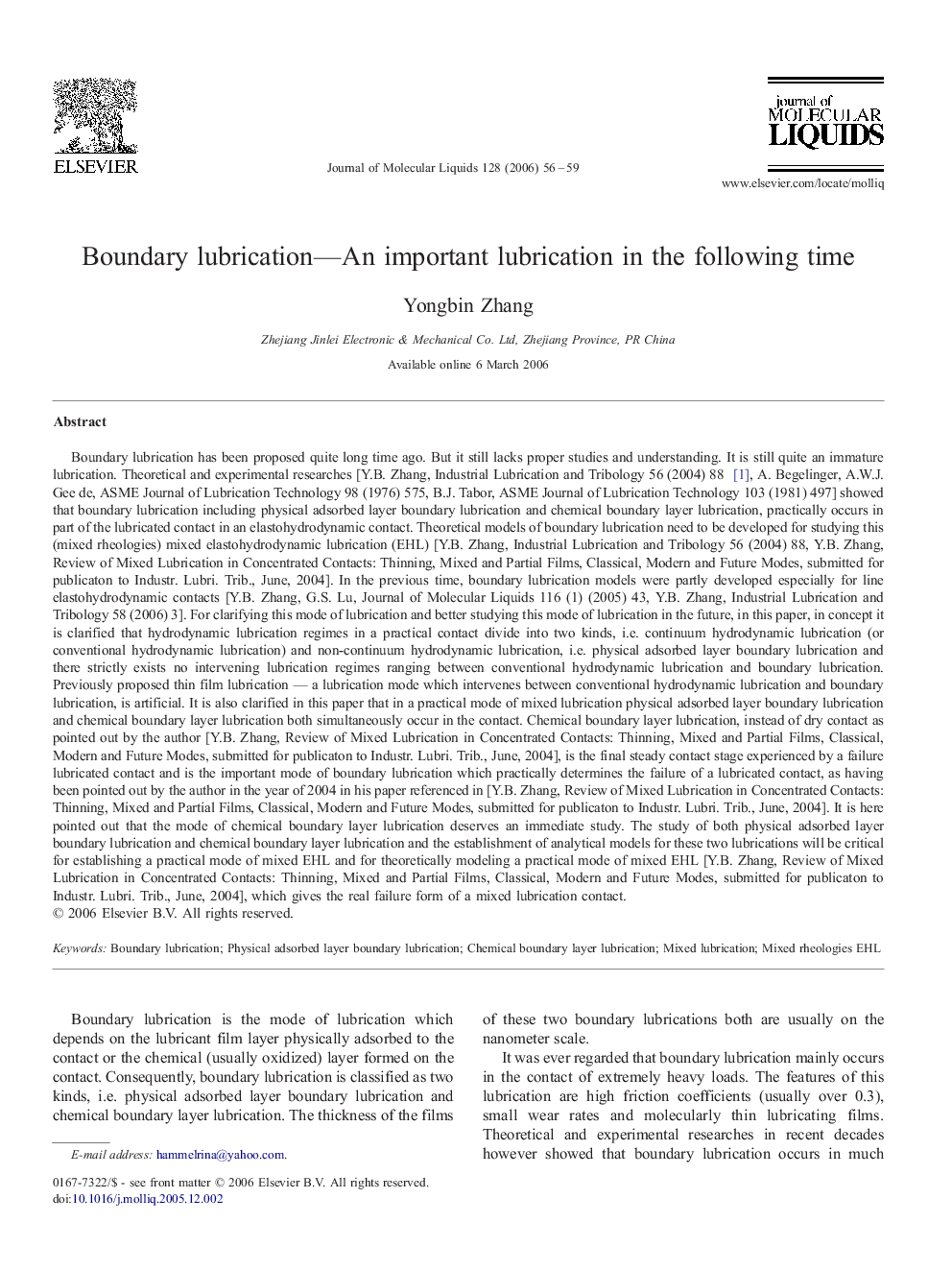| کد مقاله | کد نشریه | سال انتشار | مقاله انگلیسی | نسخه تمام متن |
|---|---|---|---|---|
| 5413812 | 1506635 | 2006 | 4 صفحه PDF | دانلود رایگان |
عنوان انگلیسی مقاله ISI
Boundary lubrication-An important lubrication in the following time
دانلود مقاله + سفارش ترجمه
دانلود مقاله ISI انگلیسی
رایگان برای ایرانیان
موضوعات مرتبط
مهندسی و علوم پایه
شیمی
شیمی تئوریک و عملی
پیش نمایش صفحه اول مقاله

چکیده انگلیسی
Boundary lubrication has been proposed quite long time ago. But it still lacks proper studies and understanding. It is still quite an immature lubrication. Theoretical and experimental researches [Y.B. Zhang, Industrial Lubrication and Tribology 56 (2004) 88 [1], A. Begelinger, A.W.J. Gee de, ASME Journal of Lubrication Technology 98 (1976) 575, B.J. Tabor, ASME Journal of Lubrication Technology 103 (1981) 497] showed that boundary lubrication including physical adsorbed layer boundary lubrication and chemical boundary layer lubrication, practically occurs in part of the lubricated contact in an elastohydrodynamic contact. Theoretical models of boundary lubrication need to be developed for studying this (mixed rheologies) mixed elastohydrodynamic lubrication (EHL) [Y.B. Zhang, Industrial Lubrication and Tribology 56 (2004) 88, Y.B. Zhang, Review of Mixed Lubrication in Concentrated Contacts: Thinning, Mixed and Partial Films, Classical, Modern and Future Modes, submitted for publicaton to Industr. Lubri. Trib., June, 2004]. In the previous time, boundary lubrication models were partly developed especially for line elastohydrodynamic contacts [Y.B. Zhang, G.S. Lu, Journal of Molecular Liquids 116 (1) (2005) 43, Y.B. Zhang, Industrial Lubrication and Tribology 58 (2006) 3]. For clarifying this mode of lubrication and better studying this mode of lubrication in the future, in this paper, in concept it is clarified that hydrodynamic lubrication regimes in a practical contact divide into two kinds, i.e. continuum hydrodynamic lubrication (or conventional hydrodynamic lubrication) and non-continuum hydrodynamic lubrication, i.e. physical adsorbed layer boundary lubrication and there strictly exists no intervening lubrication regimes ranging between conventional hydrodynamic lubrication and boundary lubrication. Previously proposed thin film lubrication - a lubrication mode which intervenes between conventional hydrodynamic lubrication and boundary lubrication, is artificial. It is also clarified in this paper that in a practical mode of mixed lubrication physical adsorbed layer boundary lubrication and chemical boundary layer lubrication both simultaneously occur in the contact. Chemical boundary layer lubrication, instead of dry contact as pointed out by the author [Y.B. Zhang, Review of Mixed Lubrication in Concentrated Contacts: Thinning, Mixed and Partial Films, Classical, Modern and Future Modes, submitted for publicaton to Industr. Lubri. Trib., June, 2004], is the final steady contact stage experienced by a failure lubricated contact and is the important mode of boundary lubrication which practically determines the failure of a lubricated contact, as having been pointed out by the author in the year of 2004 in his paper referenced in [Y.B. Zhang, Review of Mixed Lubrication in Concentrated Contacts: Thinning, Mixed and Partial Films, Classical, Modern and Future Modes, submitted for publicaton to Industr. Lubri. Trib., June, 2004]. It is here pointed out that the mode of chemical boundary layer lubrication deserves an immediate study. The study of both physical adsorbed layer boundary lubrication and chemical boundary layer lubrication and the establishment of analytical models for these two lubrications will be critical for establishing a practical mode of mixed EHL and for theoretically modeling a practical mode of mixed EHL [Y.B. Zhang, Review of Mixed Lubrication in Concentrated Contacts: Thinning, Mixed and Partial Films, Classical, Modern and Future Modes, submitted for publicaton to Industr. Lubri. Trib., June, 2004], which gives the real failure form of a mixed lubrication contact.
ناشر
Database: Elsevier - ScienceDirect (ساینس دایرکت)
Journal: Journal of Molecular Liquids - Volume 128, Issues 1â3, 15 September 2006, Pages 56-59
Journal: Journal of Molecular Liquids - Volume 128, Issues 1â3, 15 September 2006, Pages 56-59
نویسندگان
Yongbin Zhang,